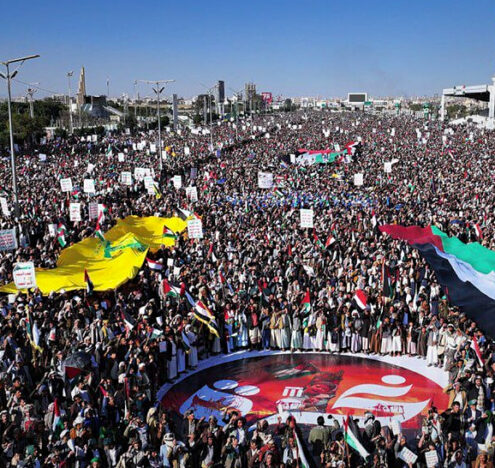“Adults in a Room” is a series in collaboration with The Atlantic Council’s New American Engagement Initiative (NAEI). The series stems from NAEI’s monthly networking events that call on analysts to gather virtually and hash out a salient topic. This series aims to give you a peek into their Zoom room and a deep understanding of the issue at hand in less than the time it takes to sip your morning coffee, without the jargon, acronyms, and stuffiness that often come with expertise.
While Russia’s war against Ukraine has featured a return to conventional warfare, with columns of tanks and helicopter sorties bombarding the country, the predominant form of conflict between major powers in the current era has been in the so-called “gray zone.” Of course, there is a debate over gray zone conflict, but it’s generally non-kinetic actions that attempt to gain advantages over an adversary. Everything from propaganda to Stuxnet, election interference to the use of mercenary groups falls into the broad category of gray zone activities. So what does the future of conflict look like in the gray zone? And how should the United States, in particular, manage in this space where so far it has appeared at a disadvantage to rivals like Russia and China?
Should gray zone efforts fail, and states resort to conventional war, have those gray zone “warriors” — civilians who took up arms — crossed an invisible line?
The Atlantic Council’s New American Engagement Initiative’s (NAEI) March roundtable brought several experts to discuss gray zone conflict and how that space of conflict and competition is evolving. Much of the discussion revolved around the constraints facing the United States effectively operating in the gray zone compared with its adversaries. For example, participants made the case that China and Russia have invested heavily in gray zone capabilities because they cannot compete with the conventional capabilities of the United States. Ultimately, there was recognition that the United States and its allies need to invest more in constructive policies, such as economic cooperation or cultural exchange, to counteract some of the maligned gray zone acts. Four experts shared their takeaways from the discussion below.
Zuri Linetsky, Research Fellow, The Eurasia Group Foundation
As modern states evolved, they created systems to regulate their behavior. States sought to eliminate all forms of nonstate violence because it could unintentionally provoke interstate conflicts. But, states could not eliminate all forms of non-state violence. Modern gray zone operations leverage gaps in international law about the use of force and the principle of non-intervention. To operate in the gray zone, the US must address these gaps.
Gray zone operations confound international legal definitions of who is a combatant, what is a weapon, and what constitutes a war — and they maximize deniability for actors who implement them. Moreover, as large states successfully deploy gray zone campaigns, smaller states have an incentive to emulate them. These factors make gray zone operations a direct threat to the effectiveness of international law.
To address these challenges to international law, the US must take three steps. First, it should publicize strategies for nullifying the effectiveness of gray zone operations. For example, the US must clarify that grey zone operations will not be met in kind but will automatically lead to escalation, nullifying their value. Second, US laws must define gray zone operations and create a legal framework. Such laws will help categorize future gray zone campaigns and create accountability mechanisms for all international actors. And third, the US must cooperate with other states at the UN to establish common standards of behavior and accountability for gray zone campaigns and fill gaps in international law about the use of force. Filling these gaps will create buy-in for regulating gray zone operations, avoid unintentional interstate conflicts, and limit the number and types of actors that can engage in these operations.
Kelly Grieco, Senior Fellow, Atlantic Council’s New American Engagement Initiative
Before Feb. 24, 2002, Russia had earned a reputation in the West as a master of the so-called gray zone for its activities in Crimea. President Vladimir Putin had used a combination of cyberattacks, covert actions, propaganda disinformation campaigns, and a mix of proxy forces and Russian troops — almost everything short of full-scale war — to gain control of Crimea and undermine the Ukrainian government in 2014. But Russia’s invasion of Ukraine indicates that Russia’s gray-zone operations and tactics largely failed.
Russia’s shift from fighting a gray-zone conflict to waging open war points to an urgent need to distinguish between means and ends better. Though gray-zone activities are a means to an end, US policy has become overly preoccupied with the means — that is, the tactics of the gray zone. A great deal of the focus is on expanding the “dark arts” to the digital world through cyber hacks, malware, and social media campaigns. Since so many of these dark arts challenge the norms and values of the liberal world order, they cast a sinister shadow that reduces the policy discussion to tactical considerations of the means the adversary employs without ever answering the strategist’s question: So what? Is it even practical?
Instead, it assumes a de-facto threat because the means are considered illegitimate. But Putin’s support to Russian-backed separatists in Ukraine led the Ukrainian government to improve its military capabilities and NATO to provide massive military aid and training to the Ukrainian armed forces. At the same time, Russian political and economic subversion provoked political opposition and backlash from the Ukrainian people. Despite all the hype, Russian gray-zone activities in Ukraine since 2014 were largely counterproductive. Instead, Putin opted for a full-scale invasion of Ukraine, which has its own dangerous implications.
John Barranco, US Marine Corps fellow, Atlantic Council’s Scowcroft Center for Strategy and Security
Since the 2016 election, the US has been paying close attention to Russia’s gray zone. There is no question that the Russian threat is real and worthy of our attention. However, China’s gray zone operations pose a more significant threat to the US-led rules-based global system. In his remarks at the Aspen Security Forum in 2018, FBI Director Christopher Wray described China as “the broadest, most pervasive, most threatening challenge we face as a country.” In his January 2022 speech at the Reagan Presidential Library, he returned to this theme again. He said that the Chinese government is stealing more information from the US than all other countries combined.
In recent years, there have been numerous incidents to back up Wray’s assessment. In 2015, China hacked the Office of Personnel Management (OPM) and stole the data on millions of federal employees, likely including SF-86 top-secret security clearance investigations. These documents provide them with a treasure trove of detailed personal information on members of the executive branch, including senior officers of the armed forces. In 2018, the FBI discovered that Beijing had recruited a member of the Chairwoman of the Senate Intelligence Committee’s staff to spy on her for the last 20 years. In 2020, the FBI revealed that China had planted one of its intelligence agents as a fund-raiser and confidant to a member of the House Intelligence Committee. In our colleges and universities, China’s Confucius Institutes, which fall under the Chinese Communist Party’s (CCP) Central Propaganda Department, work to improve China’s image abroad and, according to a 2019 study in the Washington Post, have had some success in doing so. The Confucius Institutes are not the only Chinese effort at penetrating American universities. Professors at Harvard, the University of California, Los Angeles, and a researcher at the University of Kansas have all been convicted of federal felonies related to their illegal activities on behalf of China. In 2020, China surpassed the US as the largest box office in the world. Hollywood studios avoid depicting China’s oppression of its Uyghur minority, crackdowns in Hong Kong, or persecution of religious minorities to access that market.
In summary, Wray was correct. China is the number one threat in the gray zone. Their operations there run the gamut from more traditional espionage activities like HUMINT collection, cyber hacking, industrial espionage, and stealing classified research to applications of soft power like influencing the depictions of the CCP that Americans see in movies and television. The Russian threat is not going away but is secondary to China.
Ellen Laipson, Director for the Center of Security Policy Studies, George Mason University
It is increasingly hard to determine where the line between a state of peace and a state of war sits. As countries use unconventional tools, such as economic pressure, cyberattacks, or other nonmilitary ways to shape adversaries’ behavior, a new set of troublesome issues arises. Our classic understanding of how nations move into hostilities assumes that the key players are the armed forces of sovereign states and that the leaders of those states have command authority over their soldiers. The soldiers (sailors, airmen, etc.) are also assumed to have been trained in the laws of warfare and understand their rights and responsibilities under international law, the Geneva Convention in particular.
Yet, on the slippery slope from economic coercion to full-scale combat, civilians may be mobilized to implement “gray zone” activities that are technically not warfare but that have the potential to do considerable physical harm to a targeted population. We are currently seeing this in Ukraine, where ordinarily Ukrainians are taking up arms to defend their neighborhoods against Russian soldiers.
Should gray zone efforts fail, and states resort to conventional war, have those gray zone “warriors” crossed an invisible line? For example, could they be considered “enemy combatants,” even though they may reside in civilian institutions? At the national and international levels, our legal frameworks may need to be updated to address such ambiguous situations.




















